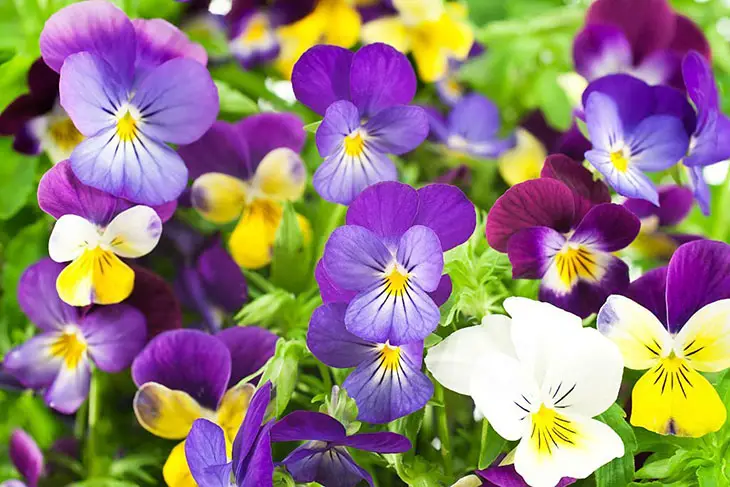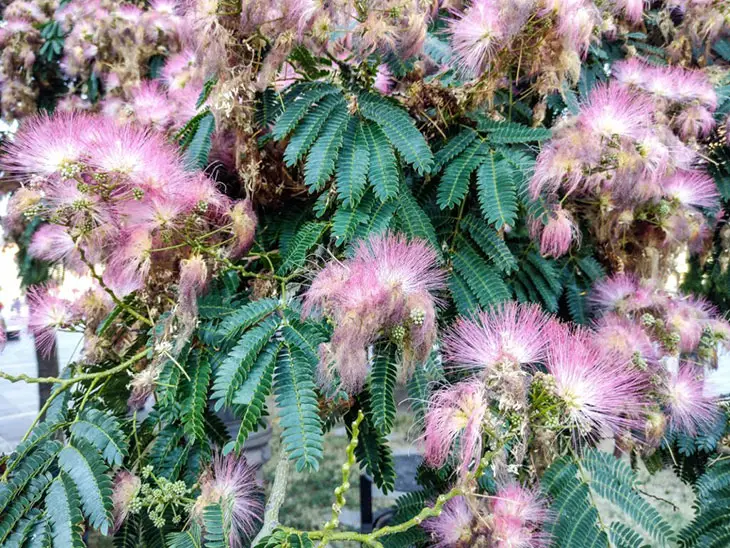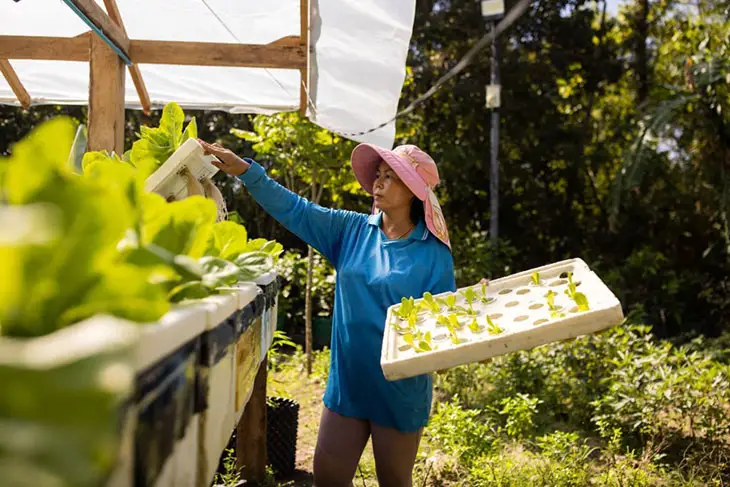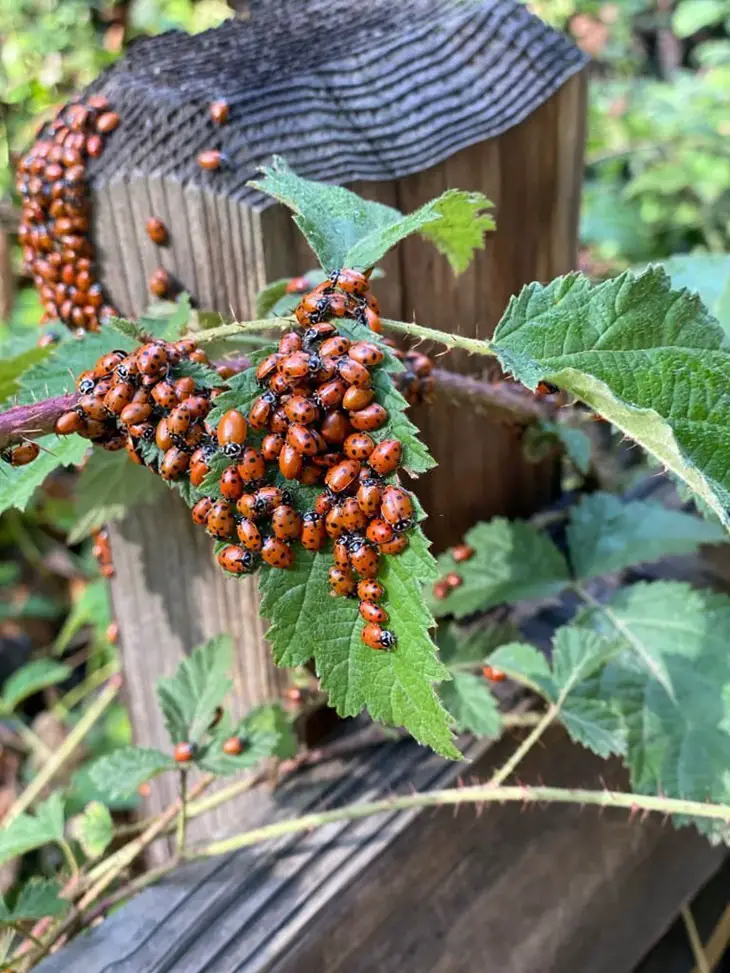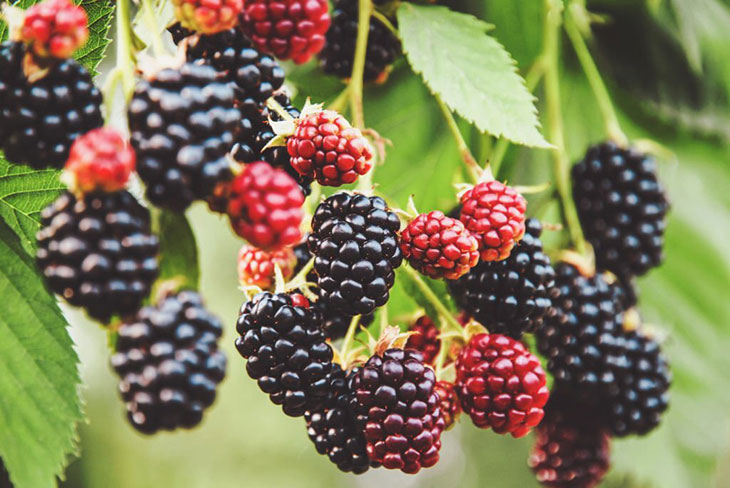
Elegant climbing vines that make their way onto balconies and walls bring a gorgeous sight to any house.
But do you know that aside from aesthetic charms, their mouth-watering fruits are also worth mentioning?
My guide will give beginners a wild ride through the 26 most popular fruits that grow on vines; keep scrolling.
A Full List of 26 Fruits That Grow on Vines
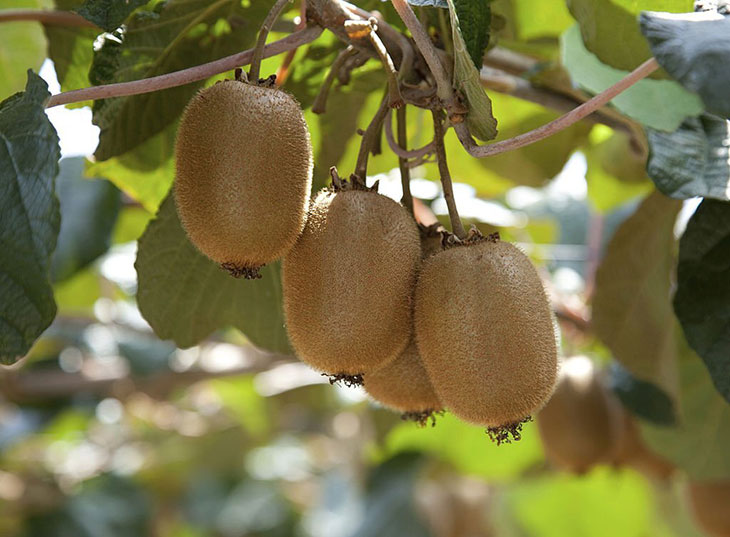
Kiwi, Armenian cucumbers, grapes, passion fruits, and dragon fruits are some of the most common fruit on vines, each demanding different water levels, temperature tolerance, and fertilizing frequencies.
There are still other plants on my list, check them out.
Kiwi Fruits
Kiwis are commonly found on climbing perennial vines of 14-18 feet in height and 12 feet wide. They adore full sun and can bask for hours under direct sunlight on tall, strong trellis or pergolas.
Gardeners are generally recommended to plant these kiwi vines in well-drained, loamy, and rich soil.
While some prefer poor soil to save budgets and control lush growth, studies have proved that the kiwis develop faster on high-quality garden beds mixed with compost, manure, or similar-nature organic matter.
For hardy kiwi fruit vines, remember to keep the soil’s pH at 5 to 6.5.
Armenian Cucumbers
Though Armenian cucumbers can also grow on the ground, their growth rates increase significantly when the vines are lifted off.
I suggest choosing a bright area full of sunlight for them (at least six to eight hours of direct light). For afternoons, shades are preferred – but not really necessary for scorching hot climate regions.
Most importantly, avoid overcrowding these vine fruit plants. Otherwise, your cucumbers will be more vulnerable to diseases and pests (squash bugs, powdery mildew, etc.).
- With vertical gardening, allow one foot or 30 cm in minimum between their roots.
- With plants that sprawl freely, raise that number to 2 to 3 feet (or 60 to 90 cm).
Grapes
What fruit grows on vines? Grape vines are undoubtedly among the most popular climbing vines, providing a satisfying visual treat with their hanging, clustered fruits and lush foliage.
Better yet, they are pretty low maintenance and rarely need watering (except for those planted on very sandy soil). Thus, be cautious with your watering sessions:
- Only apply water to their root zones
- Do not let any drop linger on the foliage to keep grape diseases at bay.
- Reduce your watering during fall, especially if the vines are still young. That way, the plant’s canes will be encouraged to harden, preparing themselves better for the harsh winter.
Passion Fruits
With tarty, sweet flavors, these exotic vining fruit have earned quite a dedicated fanbase. They like to thrive on tall, heavy-duty trellis spreading 15-30 feet.
Passion fruit vines hate “wet feet” and suffer higher risks of root rots on wet soils; thus, remember to select well-drained slopes and garden beds for their plantations.
Add some lime, composted manures, and organic matter to the ground before planting, too.
Other tips to keep in mind:
- Prune the plants in early spring
- Water them only once per week in summer and spring
- Choose a frost-free, sunny spot for them to grow
- Keep competing weeds and plants away
Dragon Fruits
Another name to consider is dragon fruits, which usually grow on succulent, ornamental vines of 20 feet in height.
Once the root system is established, these plants can keep churning out tasty fruits for 20 to 30 years.
Unsurprisingly, dragon fruits do better in warm climates (mild winters, no frost). Occasional bursts of chilly weather can still be tolerated, but it would be better to keep them beyond 10 degrees F.
On another note, some training might be required to avoid scrambling scraggy messes: plant them against thick stakes, then tie their main stems to encourage straight, vertical growth.
Gooseberry
These sweet-tart power-packed fruits grow in well-draining, rich soil on 4-foot-tall vines.
In general, gooseberries are very low-maintenance; they barely need water and can tolerate both full-sun and partially-shade areas.
There is only one minor problem: harvesting them can be quite a challenge due to the thorns. Always wear pants, long sleeves, and gloves during the task.
Plus, vines loaded with gooseberries can easily flop over. Trellis or stake them to prevent it from happening.
Mouse Watermelon
Also referred to as “Cucamelons,” these mouse watermelons look like small watermelons but with a cucumber taste.
Their delicate stems thrive under full sun and can be properly trained along garden fences and long trellis.
Since Cucamelons aren’t cold hardy, temperatures below 50 degrees (or 10°C) will not last them very long.
For other seasons except for winter, zone 2 to zone 11 are their best growth medium. In winter – provided the ground does not freeze – you can put them in zone 9 onwards.
Honeydew Melon
The whitish-green, oval fruits rank among many people as one of the most delicious fruits ever known.
Unfortunately, their root systems are pretty shallow, so you need extra thick mulch layers to keep soil temperature and moisture.
Keep the honeydews well-watered in growing seasons (especially throughout dry spells).
Since they need at least 1 inch of weekly rain in these critical periods, I suggest using rain gauges to check whether more water needs to be added.
Watermelons
Watermelons need 6 to 7 hours of thriving, bright sunlight per day.
Sure, they can still tolerate partial shade in hot climates, but full sun is still preferred for their sugar development.
Not to mention, too much shadiness may reduce the fruit’s numbers and sizes.
Regarding watering, they only need regular water after the first transplantation.
Once the fruits start to set, you can reduce the watering frequency; their extremely long and deep roots are more than enough to help them withstand short dry sessions.
Blackberry
Blackberry also receives favorable feedback due to its tarty juices.
Taking care of blackberries is straightforward, though you should note down the slightly differing water demands during and after their first 3 weeks:
- During the first 3 weeks: Water them in the daytime and as frequently as possible. The first soil inch must always stay moist.
- After the first 3 weeks: Give them 1 to 2 inches of moisture depth each week (growing season) and 4 inches (harvest). Since blackberry plants are shallow-rooted, always keep the moisture at the very surface.
Muskmelon
Farmers and gardeners will need extremely strong trellises to support the vertical growth of these vines with fruit.
It would be even better if you could support each melon with a jute bag or cloth.
Water them early every morning, and keep the leaves from getting wet to prevent fungal diseases (you can rely on drip irrigation methods for even and consistent watering).
You can reduce the water once the fruits are produced – since dry and hot weather manifests the best, sweetest melons.
Too much rainfall during its ripening stage, otherwise, may actually bland out the fruit’s flavor.
Hops
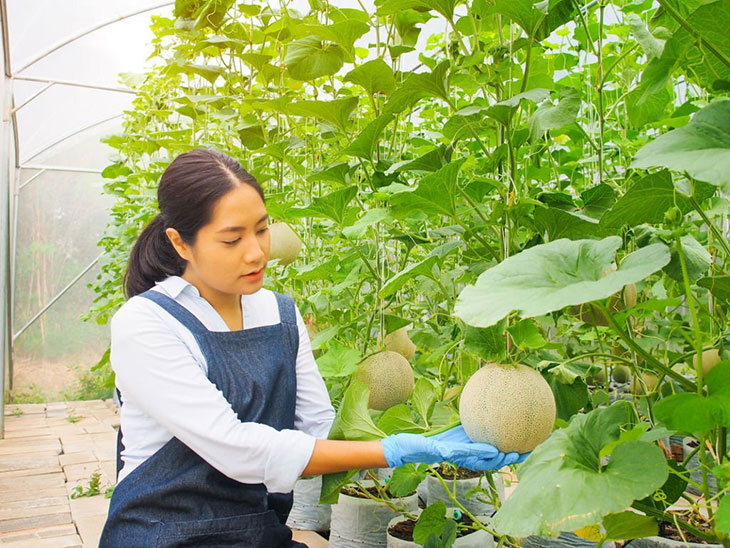
No partygoer has not heard of hops plants and fruits; their flavor preservation properties lend excellent bitterness to any glass of beer and alcohol!
Hops happily bask in well-drained/fertile soil and part sun. Sure, full sun is still the best option if you aim for the best crop quality.
But for those who only use hops as decorative walls or privacy screen vines, part sun should do.
Tend to the water and soil regularly till the plant root is established, and you are good to go!
Sugar Cube Cantaloupes
As a muskmelon hybrid, sugar cubes set themselves apart from other melon siblings with their exceptionally sweet and juicy taste.
Most sugar cubes can survive outdoors (even during hot summer).
Still, experts recommend growing them in biodegradable containers indoors for the first 3-4 weeks when the last frosts start melting to get them a good head start.
This tip is particularly helpful if you are from colder climate regions.
Swiss Cheese Plant Fruit
What fruit grows on a vine? Swiss cheese plant fruit is one to name.
Contrary to popular belief about tropical plants, their vines prefer drying time between two waterings. Very wet and moist soil does not suit them and might even lead to root rot, so be aware!
The best way to check whether the soil has been dry is to insert your fingers into it every few days.
Chocolate Vine
Provide the chocolate vine with weekly watering for the first few weeks. Once its system has been built properly and started producing fruits, switch to 1-2 inches of water per week.
Most importantly, only grow chocolate vines at 55-85 degrees F to give the fruits their best taste.
Raspberries
These fruits do not need any introduction; the sweet, acidic, yet natural profile is among the reasons they are included in so many dessert recipes.
Keep the vines watered evenly during summer (the topsoil inch must always be moist). Avoid watering them when winter comes, though, as the excess water may lead to root rots.
Strawberries
Here comes another worldwide-famous vine with fruit that has been present in millions of family meals and desserts!
Strawberries can tolerate many soil types, but loamy soil is still everyone’s favorite due to exceptional drainage.
- If you only have clay soils, mix about 4 extra inches of compost and rake them into mounds to boost their drainage.
- For sandy soil, remove the weeds and mix in about 1 inch of rotted manure.
Cantaloupe
Cantaloupes require lots of water, so always check the soil moisture every 2-3 weeks and water the plants regularly (but do not wet the leaves, by the way).
Also, eliminate weeds and mulch well to give the vines enough room for free spread.
Bitter Melon
Plant the bitter melon in bright, full-sun areas (at least six hours of light are required).
For hot climate areas like the Southern regions, it is alright to seed them in light-shade spots – provided that the vines can still crawl to full-sun sites later on.
Chayote
Remember to sow the fruits and seeds at least ten feet apart, and set sturdy supports or trellises for these vigorous climbers.
One common beginner mistake is to let the maturing fruits contact the soil; do not follow in their footsteps, unless you want to germinate and spoil the fruits’ flavors.
Cucumbers
Cucumbers need fertile, warm soil at 6.0 – 6.8 pH, although some alkaline soil at 7.6 can still be tolerated.
To manifest the best root environment for the harvest, I recommend working a few layers of enriched compost organics into the garden’s top inches, and spacing the vine plants at least one foot apart.
Also, in regions that have cool and long springs, you may consider warming the soil up with black plastic coverage.
Other alternatives to black plastics are organic mulch, chopped leaves, wheat straws, or pine straws.
Peas
What grows on vines that is both fruit and veggie? Like most vine options on my list, pea plants barely require any attention.
The upkeep process is a breeze from beginning to end; still, to ensure maximum growth and fruiting, there are some basic tips to keep in mind:
- Water them regularly until their first growing cycle is over. Be mindful of overwatering, by the way.
- Despite being drought-tolerant, they still need supplemental irrigation during extremely dry, hot weather.
- Pinch their growing tips frequently to prevent legginess and encourage lush growth simultaneously. You do not need any fertilizer for the task.
Pole Beans
Few vine fruit plants can be as low maintenance as pole beans. Their exceptional ability to thrive upon poor soil can free busy gardeners of meticulous fertilizing.
Not to mention, fertilizing may actually lower their yields and hence, should be avoided altogether.
But watering is another story; no pole beans can live without it. Water them during their plantation and whenever rainfalls are scarce.
Ensure they get one inch of water/rainfall (minimum) per week to fill out the pods.
Furthermore, do not forget to keep weeds away from their base so that the beans can soak up enough nutrients and moisture.
Pumpkins
Since pumpkins need at least 2 inches of rainfall/water per week, you should carry out deep watering during mornings and hot afternoons.
Unless the weather is extremely sunny, avoid watering the fruit and foliage at all costs; they will invite diseases and rots!
Also, weed gently. These pumpkins are notorious for shallow, easy-to-damage roots.
And tread cautiously around their more delicate vines; how the pumpkins taste in the future depends entirely on them!
Tomatoes
Vine tomatoes come in several varieties, but their upkeep requirements are more or less similar!
For starters, devote a sunny, prime spot to their growth; a tasty tomato demands at least six to eight hours of direct, full sunlight.
And you should give these long-vined, robust varieties plenty of space for spreading – at least two-feet gaps.
Once done, improve the plantation sites by mixing premium-quality garden soils (compost-enriched ones will be even better) into the base.
Winter or Summer Squash

Water the squash often and deeply during summer months, and mulch the area to keep moisture loss at bay. Once the first bloom shows up, fertilize the squash immediately.
The same sentiment applies to winter squashes.
Unlike other vines that grow fruit, which do not need a lot of watering in winter, the squash’s big fruit and size means they are still very thirsty during cold seasons. Keep that in mind!
Are There Dangerous Vine Fruits?
Unfortunately, yes. The Canada Moonseeds (also known as Menispermum Canadense) are climbing vines with fruits and leaves strikingly similar to grapevines.
But they aren’t grapes whatsoever, even causing death to anyone who has a bite!
To learn how to tell grapevines apart from other wild vines, click here.
Conclusion
Despite dissimilar care and requirements, fruits that grow on vines are generally undemanding and very low-maintenance.
All you need to do is water them regularly, pinch and prune the dead vines, choose the appropriate soil, and keep pests away. Write to me if you still seek any answer on gardening.
